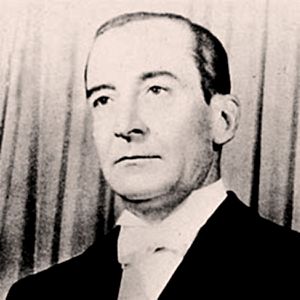Pedro Eugenio Aramburu facts for kids
Quick facts for kids
Pedro Eugenio Aramburu
|
|
|---|---|
 |
|
| President of Argentina | |
|
De facto
|
|
| In office November 13, 1955 – May 1, 1958 |
|
| Appointed by | Military junta |
| Vice President | Isaac Rojas (de facto) |
| Preceded by | Eduardo Lonardi (de facto) |
| Succeeded by | Arturo Frondizi |
| Personal details | |
| Born |
Pedro Eugenio Aramburu Silveti
May 21, 1903 Río Cuarto, Córdoba, Argentina |
| Died | June 1, 1970 (aged 67) Carlos Tejedor, Buenos Aires, Argentina |
| Cause of death | Assassination |
| Resting place | La Recoleta Cemetery |
| Political party | Union of the Argentine People |
| Spouse | Sara Lucía Herrera |
| Signature | |
| Military service | |
| Allegiance | |
| Branch/service | |
| Years of service | 1922–1958 |
| Rank | |
Pedro Eugenio Aramburu Silveti (born May 21, 1903 – died June 1, 1970) was an Argentine Army general. He was a leader of Argentina from November 13, 1955, to May 1, 1958. He played a big part in the Revolución Libertadora. This was a military takeover against President Juan Perón in 1955.
Aramburu was later kidnapped by a group called Montoneros on May 29, 1970. He was killed as an act of revenge. This was because of his strong actions against some Peronist supporters in 1956.
Contents
Aramburu's Military Path
Pedro Aramburu studied at the National Military College. He began his career in the army in 1922 as a sub-lieutenant.
He slowly moved up the ranks. By 1939, he became a major. In 1943, he taught at the Escuela de Guerra (War School). He later became the director of this school.
In 1951, he was promoted to brigadier. By 1955, he was the Commander in Chief of the Army. His final rank was lieutenant general in 1958.
Leading Argentina
Aramburu became the de facto (meaning "in fact" or "in reality," but not officially elected) president of Argentina. He held this position from November 13, 1955, to May 1, 1958.
The Revolución Libertadora was a military movement that removed Juan Perón from power. This happened partly because of Perón's actions against newspapers. He also jailed leaders who disagreed with him. For example, he had offices of critical newspapers damaged. He also put Ricardo Balbin, an opposition leader, in jail.
The military takeover led to three years of military rule under Aramburu. He promised to hold elections soon. He also said that no military officers in his government would run for office.
Aramburu's government made Perón leave the country. Perón lived in Spain until 1973. His political party, the Peronist Party, was not allowed to take part in elections.
Aramburu also changed the country's constitution. He removed the 1949 constitution and brought back the older 1853/60 version. This decision was later approved by a special meeting.
Political Life After 1958
After his time as president ended in 1958, Aramburu left the military. He then focused completely on politics.
He ran for president in the 1963 election. He was the leader of a party called the Union of the Argentine People (UDELPA). His campaign slogan was "Vote UDELPA and HE won't return." This was a clear message about keeping Perón from coming back to power.
Since the Peronist party was banned, Arturo Umberto Illia became president. Aramburu finished third in that election.
Even after the elections, the military still had a lot of power. They controlled what people could say about Peronism and its leader. Argentina's democracy was still weak. In 1966, General Juan Carlos Onganía led another military takeover, removing President Illia.
In 1970, people were talking about Aramburu possibly running for president again.
His Death
On May 29, 1970, Aramburu was taken from his apartment in Buenos Aires. Two members of the Montoneros group pretended to be army officers. The Montoneros called this kidnapping "Operation Pindapoy."
For about a month, people in Argentina wondered what happened to Aramburu. It was later found out that he had been killed three days after he was taken. His body was hidden in a farmhouse near Timote, in Buenos Aires Province. He had been shot twice. Mario Eduardo Firmenich said he was responsible for the kidnapping and death.
In the weeks that followed, the Montoneros group released many statements. They said their actions were revenge for the deaths of 27 Peronist supporters in 1956. Those supporters had tried to overthrow Aramburu's government.
Aramburu's Legacy
After he was kidnapped and killed, Aramburu became a symbol for those who were against the Peronist movement.
For Peronists, however, Aramburu's death was seen differently. They viewed it as a fair act of revenge. They remembered the deaths of Juan José Valle and Raul Tanco. These men were killed after their failed attempt to rise up against the Revolución Libertadora government.
See also
 In Spanish: Pedro Eugenio Aramburu para niños
In Spanish: Pedro Eugenio Aramburu para niños
- History of Argentina
- List of solved missing person cases

